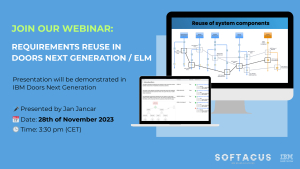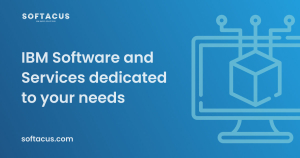Displaying items by tag: doors

Due to the high interest in our previous webinar on Linking in IBM DNG, we are excited to announce a second session on July 23rd at 3:30 pm CET. Don't miss this opportunity!
During the session, we will continue our discussion on any topics related to links in IBM DOORS Next, such as:
- Types of Links in DNG
- Widgets
- Link Reporting
- Link terms and link sharing
- Hyperlinks
- Link constraints and more
If you would like to master your link management skills and streamline your workflow in IBM DNG, but you missed the live session, contact us at This email address is being protected from spambots. You need JavaScript enabled to view it. and we will be happy to send you the recording.

In the world of IBM DOORS Next, links are more than just connections—they're the backbone of effective requirements management.
These links enable traceability, ensuring every requirement is tracked throughout the lifecycle, from conception to delivery. By linking artifacts, teams can maintain alignment, validate compliance, and streamline their development process.
Understanding and utilizing these links effectively can make a significant difference in project success, enhancing collaboration and improving overall project visibility.
Register now for our webinar on July 9th at 3:30 pm CET where we will dive into topics like:
- Creating Effective Links
- Linking by LBFA (Link By Frame Attribute)
- Ensuring Link Validity
- Advanced Link Filtering Techniques
- Optimal Link Display Practices
- Dos and Don'ts of LinkingLinking by View
- Utilizing Links in RELM (Rational Engineering Lifecycle Manager)
- Comprehensive Link Reporting
- Overview of Existing Link Types
If you missed the live session, just reach out to us under This email address is being protected from spambots. You need JavaScript enabled to view it. and we will send you the recording.

At Softacus, we excel in providing migration services from IBM DOORS to IBM DOORS Next Generation, ensuring a smooth and seamless transition for our clients.
Whether you're contemplating migrating from DOORS Classic to DOORS Next or simply seeking to explore the benefits of the latter, our upcoming webinar is for you.
Key topics that will be discussed:
- Custom link types usage for migrated links - link types can be defined based on source and target object's module path in DOORS Classic or DOORS Next
- Creation of nested Global Configurations structure based on created during migration DOORS Next streams and baselines
- Flexible definition of artifact types based either on a dedicated enumeration attribute or conditions built on queries for more attributes

As operations expand and projects grow in complexity, previously implemented information system sooner or later will require migration to a new platform. Although you may have successfully been using IBM DOORS in your engineering projects for a long time, new projects may need requirements management capabilities that are supported by IBM DOORS Next only.
To respond to the demand for sophisticated and advanced requirements management capabilities in current and future projects, DOORS Next was designed with an entirely new leading-edge architecture. Its scalability, support for Global Configuration Management, variants management and reuse are a game changer in reducing cost and time to market.
Now, the foundation for a successful migration process with a low risk for unpleasant surprises requires thorough planning and a good understanding of your current requirements meta structure.
Softacus has developed migration toolkits that help ensure a smooths transition process.
Join Jan Jancar, Solution Director and CEO of Softacus, on 30.05.2024 when he will delve into IBM DOORS and IBM DOORS Next solutions, focusing on:
- Reasons for migration / motivations behind migration and when is the perfect time to migrate
- Navigating the migration process: challenges and opportunities
- Migration targets based on object types (requirements, norms, validation, work items)
- Specific handling: data cleanup; target model; unsupported DOORS data
- Project effort estimation
- Tips and tricks
- Softacus capabilities to make migration smoother and/or possible
- Licensing
Watch the session on-demand under this link

Join us for our upcoming webinar, featuring Adrian Pitonak and Jan Jancar from Softacus, as they delve into the topic of "IBM DNG Export/Import.
Event Details:
Date: 25th of March 2024
Time: 3:30 pm CET
Location: Zoom
Link for registration: https://zoom.us/j/93121909731?pwd=dXRWb3gxUXhMUFFJdnpLYlNHSTFLdz09
Agenda Highlights:
The primary objective of the presentation is to highlight the diverse array of methods and techniques utilized with our clientele concerning Excel export and import processes.
- How to create an excel export - different ways and options
- Excel RoundTrip - how to do it
- Excel exchange with suppliers and customers
- Export of data from Publishing Engine to Excel
- Export to Excel via JRS
- Tips and tricks for Excel exporting
This event is tailored for professionals and users of Doors Classic and DOORS Next Generation (DNG), whether you hold the title of or have a keen interest in Excel export and import processes.
We are excited to invite you to our upcoming webinar on the topic of "Commenting Options in IBM DOORS NG."
Date: January 29, 2024
Time: 3:30 - 4:30 pm CEST
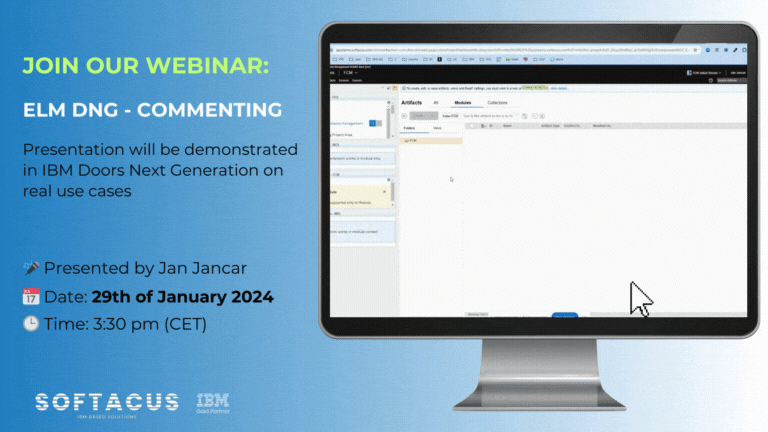
Sing up now under this link
During the webinar, we will explore essential aspects of commenting in IBM DOORS NG, including:
- Effectively using comments
- Reviewing comments
- Collaborating with internal and external stakeholders
- Techniques for exchanging comments with end customers who do not have direct access
Our Solution Director, Jan Jancar, will introduce valuable techniques, such as:
- Reviewing comments efficiently
- Commenting on base and module artifacts
- Finding comments using both out-of-the-box and attribute-based techniques
This webinar is designed to enhance your understanding of the commenting functionalities within IBM DOORS NG, providing valuable insights that can optimize your workflow.
Save your spot by registering here. After registration, you will receive a confirmation email with the webinar access details.
Feel free to invite your colleagues who might find this topic relevant.
We are looking forward to seeing you at the event!
Introduction
The history is an important part of the requirements management tool and the purpose of this article is to explain functions and capabilities of DOORS Next for working with history of requirements.
Artifact revisions
On the very basic level history of requirements management items in DOORS Next is organized on artifacts level and is presented as revisions and audit history. This information is accessible for artifacts via ‘Open history’ action in the menu (Figure 1).
Figure 1
The first tab you see when you open history is ‘Revisions’, it is splitted on ‘Today’, ‘Yesterday’, ‘Past week’, ‘Past month’ and ‘Earlier’ sections which include different versions of an artifact and baselines of project area or component. When you switch to the ‘Audit history’ tab you see only versions of a current artifact with explanation of actions performed on it and changes which were created with information on date and time and author of it.
Figure 2
Revisions can be restored to the current state. To revert the requirement to a previous state you need to use artifact menu and select ‘Restore’ action (Figure 3).
Figure 3
History in attributes
Another source of history of an artifact are system attributes, which preserve information on date and time of creation and modification of an artifact and a user who created and modified an artifact. These attributes are updated by the application on creation of an artifact (Created On for date and time of creation and Created By for username) and Modified On and Modified by for the latest modification. Additionally, if you use ReqIF import to add artifacts, attributes with the prefix ‘Foreign’ will show you related information from the source (Figure 4). Attributes with prefix ‘Foreign’ will display timestamps and usernames from the source of imported requirements.
Figure 4
Of course, a revision list and attributes of a single artifact is not enough to manage requirements history, so versions of artifacts are aggregated to baselines. The first kind of baselines is a DOORS Next baseline, in other words it can be explained as a snapshot which includes certain revisions of artifacts. Baselines are created to preserve some agreed state of requirements, artifacts cannot be edited in a baseline (Figure 5).
Figure 5
Module revisions
When we are talking about artifact revisions It is meaningful to mention that module revisions are specific - they are created when module structure is changed (a set and / or order of included artifacts) or attributes of a module as an artifact itself. So when you edit an artifact in module context without changing position of this artifact in module (Figure 6, marked with green color) - you do not create new revision of module automatically. Only insertion of new artifact, editing module attributes (Figure 6, marked with purple) or moving artifacts within a module will update attributes of a module with date & time and contributor name. To capture the complete state of a module you need to create a DOORS Next baseline.
Figure 6
History in streams and changesets
DOORS Next with configuration management capabilities has more options to manage history of requirements. First of all - streams, which allow you to have parallel timelines for different variants of requirements. All requirements in DOORS Next have their initial stream, which is the default timeline for requirements changes. DOORS Next has an option to create a parallel timeline using additional streams, which is mostly used to manage variants of requirements.In this case usually some existing version of requirements is used as an initial state for a new stream. And changes of artifacts in a new stream will not affect the initial stream - revisions of artifacts created in a new stream are visible only in this stream unless the user initiates synchronization (see Figure 7, the module is shown in two different streams - stream names and changed artifact are coloured with purple). During synchronization the user has options with merging approaches, and one of them is using changesets, which are explained below.
Figure 7
Changesets are another kind of data set in DOORS Next which can be observed in the audit history. There are two types of changesets - user created changeset (name of changeset in this case is specified by user) and internal changeset, which is a reference for changes in the audit history. Internal changesets can be found in the audit history and can be also used as an option to deliver changes across streams. Created by user changesets aggregate small changesets automatically created by DOORS Next, which can be found in audit history and in the merging menu when you deliver changes from one stream to another. Both types of changesets can be found on stream’s page, and if a stream is allowed to be edited only via changesets - it means, users are forced to create a changeset to edit requirements in a stream - a list of changesets of a stream gives you a good representation of history for a stream (Figure 8).
Figure 8
Baselines
Another functionality to manage history is Global Configuration baseline. When you enable DOORS Next project area for configuration management, links between requirements in different components are created via Global Configuration stream - you need to switch to Global Configuration context to create a link across DOORS Next components and also to see such links. As each component is baselined independently in DOORS Next, in order to preserve cross-component linkage state you need to create a Global Configuration baseline. When you perform this action, baselines are created on each component level automatically and included to a Global Configuration baseline. Switching to this baseline in the future will show you the exact state of linking at the moment of global baseline creation - proper links between proper revisions of artifacts (Figure 9).
Figure 9
Compare configuration
DNG functionality of configuration comparison can be used between streams, baselines and changesets and provides overview of changes in history and/or across variants on several layers - type system (data model), folder structure, and the data itself (including module structure, artifacts text and attribute values, links) with an option to filter changes (Figure 10).
Figure 10
Tips and tricks
- As mentioned above, baselines are created on component level (or project area level if project area is not enabled for configuration management). When number of baselines grows, some maintenance of baselines is required - to shorten the list of baselines, some of them need to be archived
- To help users with navigation in list of baselines we provide special widget, which filters from the flat baseline list those baselines which were created in a certain module context
- Links operations to not modify artifacts, link changes can be found in configuration comparison results
- To support filtering history events in a module scope Softacus provides special widget, which allows to get list of artifacts modified in a module scope
- Using change sets to update streams with link from change sets to Engineering Workflow Management work items adds context for history with explanation of a reason for changes
Introduction
IBM® Rational® DOORS® Next Generation is consistently one of the best requirements management tools out there. One of its biggest strengths is the opportunity to expand its capabilities by the people using it, so that they can utilize it to its fullest. Whether you are someone who already uses IBM® Rational® DOORS® Next Generation on a regular basis or someone who is considering using it, the knowledge of how you can optimize your work environment is the key to peak productivity in the workplace.
Purpose of the article - OS Gadgets
This article will be delving into how you can extend IBM® Rational® DOORS® Next Generation behavior with JavaScript, in particular we will be focusing on OpenSocial gadgets (widgets that are created following OpenSocial standards), as DOORS Next offers its users a JavaScript API which enables OpenSocial gadgets to automate intricate operations and work with the requirement data.
Here is how an OpenSocial Gadget is defined:
It can be defined in an XML file composed of two parts. The first one is Preferences, which determines key characteristics and gadget dependencies. The second one, Content, mainly deals with business logic and user interface. The JavaScript API makes it possible for the gadgets to be utilized to their fullest extent.
JavaScript API
First of all, let’s look at what options the JavaScript API opens for OpenSocial Gadgets. It allows the modification and viewing of artifacts, in particular to view and write attributes and acquire the current configuration context and user details. Working with links and the option to discard, add, or design artifacts in a module is also a part of this feature.
Another feature involves viewing and designating the current artifact selection and reacting to when the artifact has been interacted with (opened, selected, saved…)
When it comes to processes that are more compute-intensive, they can be performed by external services that the JavaScript API enables to assign to the task.
Furthermore, the API offers a User picker and an Artifact picker.
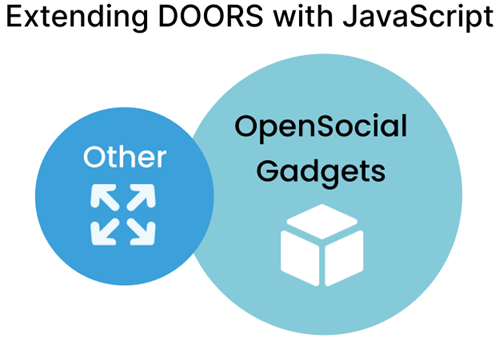
Adding and creating OpenSocial Gadgets
All of the features provided by the JavaScript API are utilized by the aforementioned OpenSocial Gadgets to help you get the most out of DOORS Next, save time and simplify work processes.
How can you start using OpenSocial Gadgets? Well, you can either add gadgets that already exist to your Mini Dashboard (a compact dashboard that you can have constantly on hand - pinned to the web UI) or you can create your own OpenSocial Gadgets.
Adding an already existing OpenSocial Gadget to your Mini Dashboard is a relatively simple way to make use of the JavaScript API and OpenSocial Gadget synergy as it requires marginally less effort compared to creating one, however creating your own one has the added benefit of having a gadget which is tailored to your specific needs. If you want to go the way of adding an OpenSocial Gadget to your Mini Dashboard, you will firstly have to work with your browser, then with a requirements module and lastly with the Mini Dashboard itself, this is also where you will spend most time during the process.
Creating a new OpenSocial Gadget can take significant effort and proficiency in JavaScript, especially if it's for complex tasks but the hard work pays off once you can actually utilize it since it will be engineered to do exactly what you need it to do.
While the entire creation process is too complex to be described in this short article, it can be boiled down to six essential steps.
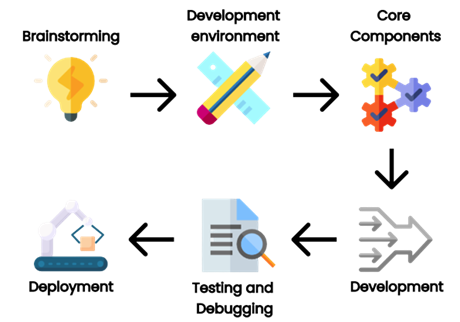
The first step will be the most important for the development as you have to establish the goal for its functionality and what will it be used for. This is crucial because having a clear aim in mind will greatly help you with the creation and implementation process.
For the second step, you will need to acquire the tools and libraries essential for developing your gadgets (e.g. web server, text editor, OpenSocial container). In other words, you will need to put your development environment in order.
The third step includes making the gadget XML file. This will be where the behavior and properties of your OpenSocial Gadget will be determined. CSS, HTML and JavaScript files, the name and description of the gadget, in other words, the core components of your gadget that will ensure that it works.
Now comes the development part of your creation process, as you will have to develop the CSS, HTML and JavaScript files themself, which will be used to make the layout and functionality of your gadget.
For the fifth step you will move onto one of the most critical development stages - testing and debugging, through which you can ensure that your gadget is working as intended and remove any problems that may arise. You can do this in DOORS Next Generation or in an OpenSocial container.
Finally, you should now be at the end of the journey of developing an OpenSocial Gadget and should be able to deploy it to DNG. You will most likely be doing this by uploading it to DOORS Next Generation. Then you can finally include it in a dashboard or wherever you will be able to/need it.
Additional OS related activities
Now the only thing left is to look at some additional useful information that you should know about extending DOORS Next with JavaScript. One such is knowing that you can add OpenSocial Gadgets to the Widget Catalog. This makes life much easier for you as it allows you to quickly and easily search up any gadget, which you can then add to DOORS Next if you wish to.
Another thing is, that a situation can occur when a widget makes an external request (call to an external server). If this happens, what you have to do is enable Cross Origin Resource Sharing if you wish for the request to go through.
Conclusion
In conclusion, if you want to get the most out of IBM® Rational® DOORS® Next Generation, you should definitely consider extending it with JavaScript. Since it already provides a JavaScript API that you can use to optimize and ease workload through OpenSocial Gadgets, extending IBM® Rational® DOORS® Next Generation in ways that we have described will without a shadow of a doubt provide you with a better experience when using the product.
Introduction
When it comes to achieving the goals you set, it is important to have the best tools for the job. If you are already using IBM® Rational® DOORS® or are considering using it, there exists something, which can elevate the experience of using IBM® Rational® DOORS® and allow you to further enhance its already impressive capabilities - IBM® Rational® DOORS® Requirements Management Framework Add-on (also referred to as IRDRMFAO).
Challenges
In this article you will learn about what challenges you might encounter while attaining or managing the highest possible level of process maturity and how you can easily overcome them thanks to IRDMFAO.
- Firstly you can encounter problems when it comes to adopting requirements processes and their execution, especially when they are very complex. This can be a particularly significant issue should all stakeholders be involved in the process.
- When large quantities of requirements need to be analysed, it can be quite a lengthy and difficult process, which is why it needs to be as well optimized as possible.
- Consistency can be another huge obstacle, since it’s difficult to maintain between multiple projects. However, it is crucial for success.
- You may need to reach compliance with ISO 15288 and EIA632 standards. This can prove to be quite problematic
- You can get to a point where your process data model has to be updated on the projects that you are currently working on.
Option to solve it
All of these challenges can add up to be quite a problem. Luckily, IBM® Rational® DOORS® Requirements Management Framework Add-on can help you with every single one. It is a solution, which has been created by industry experts for others in the industry, since it can be utilized by a variety of occupations, e.g. Software Engineers, Hardware Engineers, System Engineers and many more. IRDMFAO is in its essence a requirements management add-on, a solution, whose primary aim it is to help you achieve peak time optimization through getting your project on track with a practice, which is one of the very best ones possible with DOORS. To add to that, IRDMFAO is engineered to help you reach compliance with EIA632 and ISO 15288 standards and CMMI recommendations. IRDRMFAO adds utilities, a process and a data model to DOORS. However the most important thing is that all DOORS commands remain accessible for its users, because there is no interference with the DOORS layout.
Preferred solutions
IRDMFAO provides you with several features, which help overcome the aforementioned challenges, firstly, a RMF Generic Data Model (RMF is an acronym which describes information handled by the product or an action performed by the product). IRDMFAO comes up with a universal data model, however you are not limited to only using this one. As a matter of fact, you will be able to pick from an assortment of module types and relationships, which IRDMFAO provides.
In this example of a RMF model, every box serves as a module type (which serves the purpose of instantiating DOORS formal modules). There are also relationships (verifies, refers to…), which are provided by DOORS link modules and linksets.
In short, every action bolstered by the Requirements Management process handles particular elements of the data model and makes use of varying sorts of relationships and module types (also known as templates). For example, System requirements analysis makes use of UR,IDJ SR modules (UR - Users Requirements; IDJ - Issues & Decisions and Justifications; SR - System Requirements) and the “is justified by”, “satisfies”, “refers to” links.
IRDMFAO does not limit you in using a particular data model. It allows you to customize and adapt it for the needs of your project, since you can decide to only make use of some parts and then, if you see fit, continuously add more. This makes adopting requirements processes and their execution simpler and less time consuming, while also making updates to your data model more intuitive, improving efficiency and consistency in the process.
Regarding the analysis of requirements, IRDMFAO has you covered by implementing specialized facilities that will aid you with management of particularly important requirements, whether they are considered hazardous (Critical requirements) or they are especially important to the project (Key requirements). There are also those that fit into both categories. IRDMFAO offers you “Risk analysis” - a specialized view using which you can assign significance and closely observe the especially problematic requirements. Another dedicated view - “Key requirements list” - allows you to do the same with the requirements you deem to be essential for your project. This will allow you to analyze and work with large volumes of requirements requiring analysis and save you precious time while also making the whole process more efficient.
Last but not least, IRDMFAO provides its check project or module consistency tool to help you maintain peak consistency across your various projects and also modules. It is designed to serve as a precursor for a manual check, as it can notice errors and inconsistencies. You can either use it to monitor through collection of already defined rules or utilize the Integrity Check functionality, in which you can establish your own integrity rules.
Specialized solutions. Approaches, tips
Now for a bit of an inside look, let’s inspect how IRDMFAO works. It enables you to instantaneously switch between two approaches that it uses. The first is the document approach, which you can utilize to view structured information (like chapters, sections, paragraphs) or reach a state of universal and continuous visualisation.
The second, database approach, allows you to define data using attributes and evaluate information, filter only the information that matters to you through filters and view traceability matrices.
To properly utilize the advantages that IRDMFAO offers, you will have to either create a new RMF project or transfer a DOORS project that already exists into a RMF project.
An important aspect of IRDMFAO is PUID (Project Unique Identifier). In its essence, it is used as a reference name of objects handled by the product (RMF objects), for example Requirements. There are two rules for this: firstly, two different objects should not have the same PUID values and secondly, the PUID should remain constant, meaning that even after change (editing the text or relocating the object) is done to it, the PUID should not change.
You do not have to do this manually (although you can), since you can allow IRDMFAO to manage the values automatically. This is another way that IRDMFAO makes your life easier.
Conclusion
All in all, IBM® Rational® DOORS® Requirements Management Framework Add-on (IRDMFAO) is an integrated collection of tools, which is immediately usable and upholds the very best practices used in the industry, in particular regarding systems engineering activities. It can help you maximize your potential by facilitating acceleration in adoption and enactment of requirements processes. Additionally, it guarantees compliance with EIA632 and ISO 15288 standards and SEI-CMM-I recommendations, can improve consistency and drastically simplify analysing huge amounts of requirements (and much more!).






